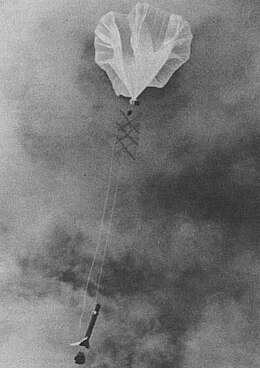 A Deacon rocket, in this case being used as a Rockoon. The Rockoon concept later succeeded the Rockair, however, note that no balloon was involved in Rockair launches. | |
| Mission type | Research |
|---|---|
| Operator | United States Navy and Air Force |
| Mission duration | 491 days |
| Spacecraft properties | |
| Manufacturer | North American Aviation and Allegany Ballistics Laboratory |
The Rockair was first suggested by Hermann Oberth in his 1929 book Wege zur Raumschiffahrt . [1] Rockair concepts were developed by both the United States Air Force and Navy, both generally finding marginal use in the concept. [1] The Air Force began studying the concept of an air-launched sounding rocket in 1947, while the Navy managed to get the first launch on August 16, 1955, using an F2H2 off of Wallops Island. The folded-fin aerial rocket(FFAR) [1] [2] reached an altitude of 54,864 m (180,000 ft). The Air Force followed up with their first air-launched sounding rocket concept on December 13, 1956, under the name "Rockaire". [3] A Deacon rocket was used, launched from a F-86 fighter aircraft.
Contents
The Navy Rockair had a total of 5 launches, while the Air Force Rockaire had a total of 4 for a combined 9 launches.
According to a NASA historical summary, [1] no important scientific research was every carried out with the Rockair concept. It had very little popularity, in contrast to the "Rockoon" which was launched in the hundreds during the 1950s.